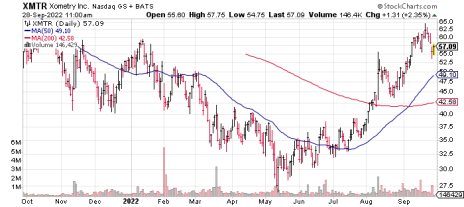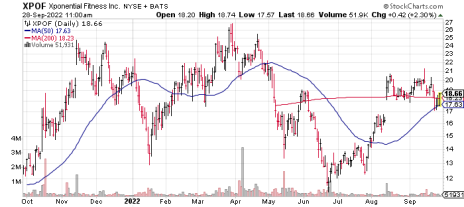Last week’s hot inflation numbers sent the broad market into a tailspin. But despite the horrid index-level performance, there were pockets of resilience, including among a number of small-cap stocks that I follow.
It may seem counterintuitive that some so-called “high risk” small-cap stocks would outperform “safer” investments like a broad market ETF.
But this is the reality in a bear market where company-specific trends and stories can make all the difference.
Here is a brief overview of what’s up with three small-caps stocks that seem to be good long-term investments right now and are shrugging off high inflation.
[text_ad]
3 Small-Cap Stocks Shrugging off Inflation
Xometry (XMTR) operates a digital marketplace for the $260 billion industrial manufacturing industry that addresses buyer and seller pain points and more efficiently matches manufacturing supply with dynamic demand.
The platform improves pricing accuracy, helps buyers source parts beyond their local network, provides revenue opportunities for sellers that extend beyond regional demand and gives large companies an enterprise-wide solution that creates workflow efficiencies.
The company’s on-demand, two-sided platform allows manufacturers to visit Xometry’s website, upload a 3D design (i.e., a CAD file) and retrieve an instant quote for the necessary parts from Xometry’s supplier network. Front door delivery and product quality are guaranteed.
Xometry was founded in 2013 by Randy Altschuler (current CEO) and Laurence Zuriff. It initially focused on the U.S. market and has since expanded operations into both Europe and Asia.
Buyers are engineers, product designers, procurement and supply chain personnel, inventors and owners of businesses of all sizes. Over six million parts have flowed through the platform
The recent acquisition of Thomas.net has helped boost growth for a company that was already growing rapidly, and it helps improve Xometry’s profit margin profile. Thomas is a well-known industrial sourcing and marketing platform that connects 1.3 million registered buyers, engineers and MRO professionals to over 500,000 North American suppliers.
In 2021 Xometry grew revenue by 54% to $218 million. Adjusted EPS was -$1.16.
In 2022, factoring in the Thomas acquisition, revenue should grow by 83% to $400 million, then grow by about 38% in 2023. EPS is trending toward break-even but will take a few more years to get there.
The company has a market cap of $2.5 billion and the stock has been doing well lately, as you can see in the chart below.
Xponential Fitness (XPOF) is the largest franchisor of boutique fitness brands in the U.S. It has roughly 2,000 studios across 48 states. It also has over 175 studios open in 11 foreign markets. The company has a market cap of $910 million.
The company’s brands cross several verticals including Pilates (Club Pilates), barre (Pure Barre), cycling (CycleBar), rowing (Row House), dance (AKT), yoga (YogaSix), running (Stride), boxing (Rumble), functional training (BFT), and stretching (StretchLab).
Xponential offers small class sizes in easy-to-access retail locations, often with several brands located in a “fitness row.” Most consumers are female, ages 20 to 60 years old. They can buy recurring memberships or just walk in. Retail locations sell both branded and third-party products.
One of the new initiatives is XPASS, an offering with three different price points/classes that gives consumers access to all brands’ class offerings on one platform.
There is also the XPLUS virtual on-demand class offering ($19 - $29.99 per month) that offers access to all brands and gives consumers an alternative to Apple Fitness+ (AAPL) and Peloton (PTON).
Finally, Xponential has a new partnership with L.A. Fitness and City Sports Club to add Xponential brands in more than 500 Fitness international locations. Buildout costs for these locations will be less than standalone studios.
The company has been a rapid grower, despite understandable challenges during the pandemic. Sales fell 20% in 2020 (pandemic) then surged by 49% to $155 million in 2021. Revenue is on pace to grow by 42%, to $220 million, this year. Analysts see low to mid-20% growth in 2023.
Xponential is also on the verge of turning profitable in the upcoming quarter. That should push EPS into positive territory for the foreseeable future. Analysts see EPS of $0.34 this year and $1.21 in 2023.
Axonics (AXNX) is a small-cap medtech stock developing disruptive solutions for patients that suffer from overactive bladder (OAB), Urinary Retention (UR) and Fecal Incontinence (FI). These ailments are often the result of abnormal communication between the brain and the bladder and bowel.
A proven treatment option is sacral neuromodulation (SNM), which involves implanting a programmable stimulator to send electrical stimulation to the sacral nerve and restore normal bladder and bowel control.
Axonics’s R15 System is a miniaturized, long-lived rechargeable neurostimulator that works for up to 15 years. It is MRI-compatible. Charging is required after one to two months.
The company also just released the F15 in early 2022. The F15 is the only truly recharge-free SNM therapy option and works for ten to twenty years.
The F15 is a home run. Some practices are switching over their entire SNM volume to Axonics and its F15.
The company’s recent Bulkamid acquisition is another success story. Bulkamid is a best-in-class urethral bulking agent for women with stress urinary incontinence (SUI). The solution is very synergistic with both the R15 and F15 solutions and may become a front-line option (replacing sling /mesh surgeries) for patients, some of whom may later progress on to an implanted SNM solution.
Axonics grew 2021 revenue by 62% to $180 million. EPS was -$1.81.
The company is on track to grow 2022 revenue by 39% to $250 million, then grow by around 28% in 2023. Forward estimates may well be conservative. Axonics is not yet profitable, and an expected EPS loss of -$1.81 this year is roughly in line with last year’s number. Bottom line improvement is seen in 2023 as EPS loss should shrink by about a third, to -$1.20.
The company has a market cap of $3.4 billion and the stock has been strong. As you can see in the chart below, AXNX is facing resistance near its all-time high of 79.8 from almost exactly a year ago. While we have seen a lot of growth stocks fail to break above staunch overhead resistance areas, the trends here are strong enough that, in my view, AXNX has a good chance of breaking out.
These three small-cap stocks are exactly the kind of stocks subscribers have access to in my small-cap advisory service, Cabot Small-Cap Confidential.
Despite a challenging market in 2022, my small-cap stock portfolio has an average return of 64% and recent picks are up 55%, 7% and 88%, even after last week’s market retreat.
Click here to learn more about Cabot Small-Cap Confidential.
[author_ad]




